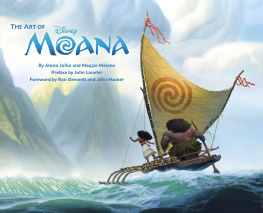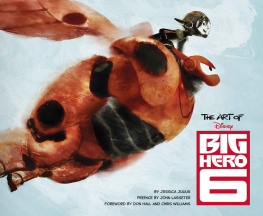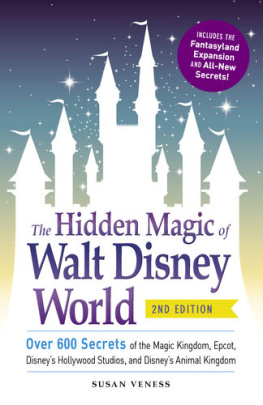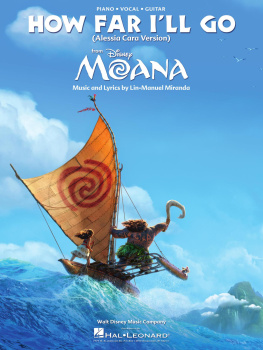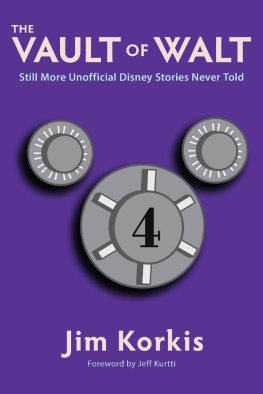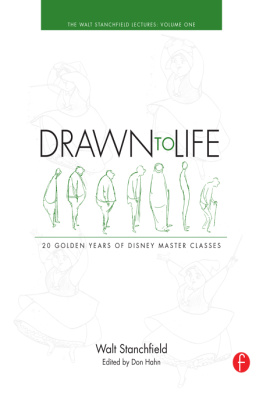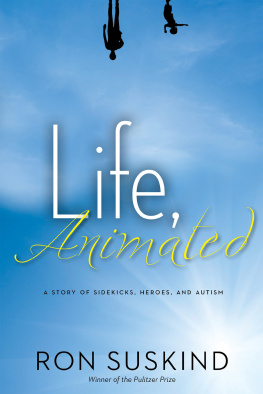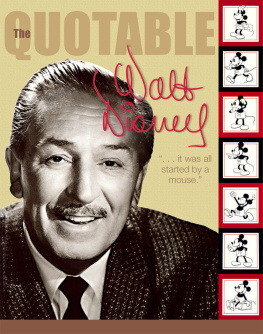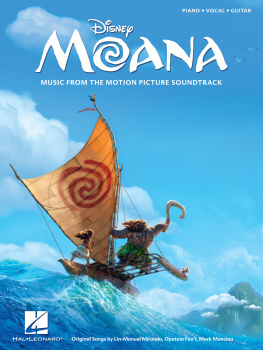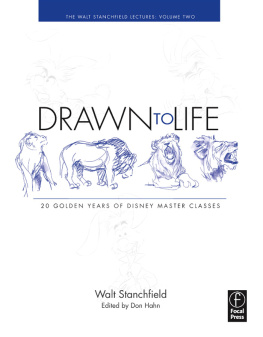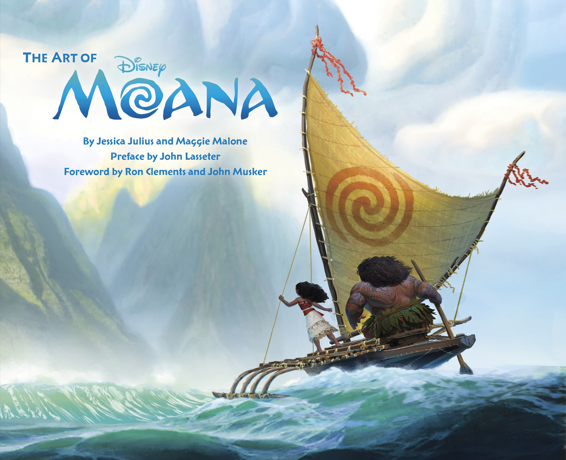
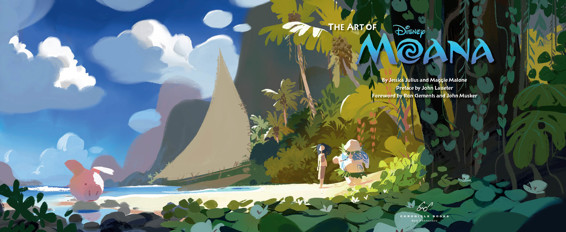
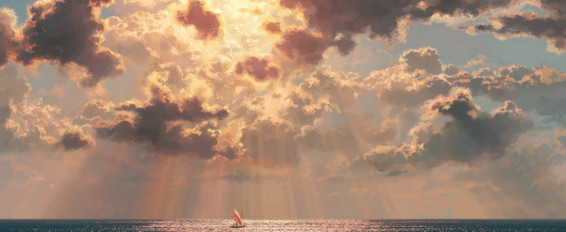
Creating a Walt Disney Animation Studios feature film involves years of inspired collaboration and the highest levels of artistry. Before the final rendered images of Moana were seen on screens around the world, the following artists contributed their talents to the digital images included in this book:
DIRECTORS
Ron Clements & John Musker
CO-DIRECTORS
Don Hall & Chris Williams
Sean Absher Aaron Adams Alex Alvarado Brett Boggs Marc Bryant Corey Butler Ian Butterfield Sara Cembalisty Jorge Cereijo-Perez Iker de los Mozos Anton Brent Homman Benjamin Min Huang David Hutchins Iva Itchevska Kate Kirby-OConnell Nikki Mull Mike Navarro Chris Pedersen Amy Pfaffinger Garrett Raine Dave Rand Tim Richards Mitchell Snary Michael W Stieber Mary Twohig Richard Van Cleave Dylan VanWormer Jose Velasquez Walt Yoder Jennifer Yu
DEPARTMENT LEADERSHIP
Carlos Cabral Jeff Draheim Robert Dressel Hank Driskill Colin Eckart Mark Empey Christopher Evart Jack Fulmer Ian Gooding Adam Green Jennifer Hager Yasser Hamed Andy Harkness Brien Hindman Mack Kablan Daniel Klug Adolph Lusinsky Dale Mayeda Robert Neuman Kyle Odermatt Hyrum Osmond Malcon Pierce David Pimentel John Ripa Matthew Schiller Bill Schwab Amy Smeed Chad Stubblefield Michael Talarico Marc Thyng Marlon West Larry Wu
ISBN 978-1-4521-5536-4 (hc)
ISBN 978-1-4521-5897-6 (epub, mobi)
Copyright 2016 by Disney Enterprises, Inc. All rights reserved.
No part of this book may be reproduced in any form without written permission from the publisher.
Designed by Glen Nakasako, Smog Design, Inc.
Chronicle Books LLC
680 Second Street
San Francisco, California 94107
www.chroniclebooks.com
Front Cover: Andy Harkness | digital; : Ian Gooding | digital
PREFACE
I ve always loved Disneys animated folktales. So when Ed Catmull and I were asked to take over the Walt Disney Animation Studios in 2006, we were eager to bring back that classic Disney folktale storytelling. But I was interested in looking beyond just European folktales. Every single corner of the earth has amazing myths and legends, and I was excited to find really great stories from all over the world that could be shared in animated films that would last for generations.
Ed and I were also happy to get to work with the incredibly talented Ron Clements and John Musker. With their combined sense of humor and storytelling ability, Ron and John have created some of the best Disney animated films of all time. So when they came up with the idea of doing a movie based on the legends of the Pacific Islands, I thought it could be absolutely amazing.
As Ron, John, and their team began to learn more about the Pacific Islands, it soon became clear that they would have to go there on a research trip. They got a lot of ribbing for this, of courseresearch in Tahiti, what a boondoggle! But it wasnt. The team met with community leaders and elders, historians, teachers, fishermen, and regular people from all over the South Pacific. They fell in love with the people they met and immersed themselves in their stories and cultures. When they shared with me the findings from their research, I had never seen a group of people who were more changed by their experience.
One of the things they discovered was the Pacific Islanders belief that the ocean doesnt divide them, it unites them. Where many people see a vast ocean dotted with tiny spots of land, Pacific Islanders see their islands as being connected by the ocean, making up a single huge region called Oceania. Many of the people Ron and John met, including the incredible musician Opetaia Foai of Te Vaka, who helped create the music for Moana, explained that this belief stems from the deep pride Islanders have in their ancestors, who were the greatest navigatorswayfindersthat the earth has ever seen. That pride in their cultural tradition, that sense of connectedness to the ocean, and by the ocean, became central to the story. Its why the storys protagonist, and the film itself, is named Moana the word for ocean in many Polynesian languages.
Ron and John have experimented with computer animated elements before, but Moana is their first film done fully in this medium. They love hand-drawn animation, but the subject matter in Moana lent itself so thoroughly to computer animation that they really opened their hearts and creativity to what it can dothe three-dimensional world, the lighting, the visuals, the colorand were amazed. It was perfect for this film.
The natural beauty of the Pacific Islands is unlike anywhere else in the world. The artists were so inspired by the richness of color and texture there, everything from the stunning landscapes to the incredible, unique designs in the islands art and crafts. Creating a world for Moana that did justice to that pushed the limits of the whole studio, from story, art, and design all the way through every aspect of the technology. Depicting the water in the way the filmmakers envisioned, for example, took a tremendous amount of R&D and experimentation. But that sort of challenge is what keeps the studio on fire. Artists love being challenged, especially when the film has such a deep heart.
The filmmakers worked hard to try to capture the beauty, richness, and depth of the Pacific Islands in Moanas world, characters, and music. But it is the spirit of the people they met, the love that they have for their community, their islands, and their cultures, that most deeply inspired them. We hope that people around the world will fall in love with the Pacific Islands as much as we did.
John Lasseter
FOREWORD
L ightning danced on the sea as we walked along the waters edge. It was approaching sunset on the first day of our research trip in the Pacific Islands. John Lasseter, our executive producer, intrigued by our pitch of an animated film set in ancient Polynesia, was sure we would strongly benefit by a deeper dive into the culture. And so, here we were, both clad in our newly purchased lavalava (colorful sarongs) wrapped around our waists, as we approached Korova, a small village on the southern coast of Viti Levu, Fijis largest island.
We were warmly greeted by the chief and elders as we sat with them in a fale (an open-air structure). They graciously accepted our sevusevu (a gift traditionally brought by visitors to their hosts). In this case it was the roots of a pepper tree, the primary ingredient for kava, a ceremonial drink we were privileged to share with them. We saw firsthand the importance of the extended family, as children and babies were looked after by many aunties. We experienced the Korova communitys generosity as they welcomed us into their wide family, saying, We havent much, but we share all that we have. And share they did, as we enjoyed not only the delicious dinner theyd prepared for us, but also their stories and moving songs, which they performed with both power and passion.
Days later, they took us sailing on a camakau (a traditional Pacific canoe powered only by the wind). As Angel, its Fijian captain, navigated the craft, he explained, You must speak gently to this ocean. It is seen as a living, sentient being with feelings and moods that needs to be treated with great respect.
Thus began our voyage into this beautiful world. We heard narratives from people fiercely proud of their cultural legacy as the greatest navigators in human history. We learned how they found their way, without the aid of any instruments, but rather by their hard-earned knowledge of the stars and currents, across the vast seas to new islands. As we continued our travels to Samoa and Tahiti, we played with kids, heard stunning hymns and harmonies in churches, and were moved by a dance choreographed and performed in memory of victims of a recent tsunami, where the dancers were topped with red headdresses like frigate birds. We discovered the importance people placed on knowing your mountain, namely the sum of all the people and their experiences that came before you. We heard the dramatic tale of Hinano, one of our cultural consultants from Moorea, and how her pregnant mother, while fishing in the lagoon, unexpectedly gave birth to her in the sea. We talked with linguists, archeologists, voyagers, and educators, whose expertise we continued to draw upon as the film took shape.
Next page
